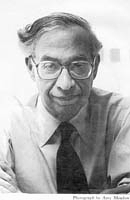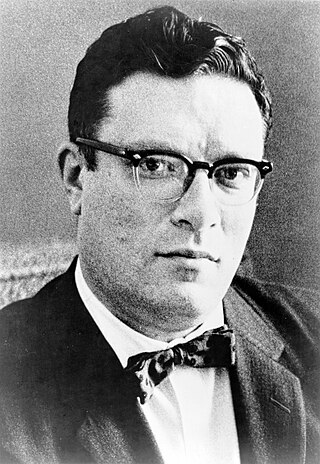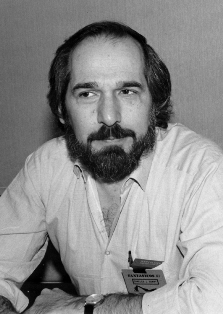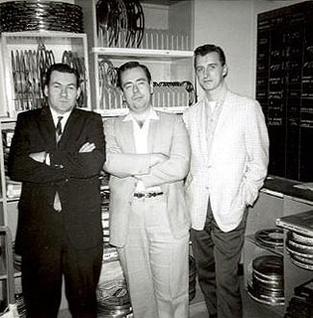
Donald Allen Wollheim was an American science fiction editor, publisher, writer, and fan. As an author, he published under his own name as well as under pseudonyms, including David Grinnell, Martin Pearson, and Darrell G. Raynor. A founding member of the Futurians, he was a leading influence on science fiction development and fandom in the 20th-century United States. Ursula K. Le Guin called Wollheim "the tough, reliable editor of Ace Books, in the Late Pulpalignean Era, 1966 and '67", which is when he published her first two novels in Ace Double editions.

Isaac Asimov was an American writer and professor of biochemistry at Boston University. During his lifetime, Asimov was considered one of the "Big Three" science fiction writers, along with Robert A. Heinlein and Arthur C. Clarke. A prolific writer, he wrote or edited more than 500 books. He also wrote an estimated 90,000 letters and postcards. Best known for his hard science fiction, Asimov also wrote mysteries and fantasy, as well as popular science and other non-fiction.

Peter Philip Carey AO is an Australian novelist.

William Francis Nolan was an American author who wrote hundreds of stories in the science fiction, fantasy, horror, and crime fiction genres.

Skeleton Crew is a collection of short fiction by American writer Stephen King, published by Putnam in June 1985. A limited edition of a thousand copies was published by Scream/Press in October 1985 (ISBN 978-0910489126), illustrated by J. K. Potter, containing an additional short story, "The Revelations of 'Becka Paulson", which had originally appeared in Rolling Stone magazine, and was later incorporated into King's 1987 novel The Tommyknockers. The original title of this book was Night Moves.

Night Shift is Stephen King's first collection of short stories, first published in 1978. In 1980, Night Shift won the Balrog Award for Best Collection, and in 1979 it was nominated as best collection for the Locus Award and the World Fantasy Award.

Asimov's Science Fiction is an American science fiction magazine edited by Sheila Williams and published by Dell Magazines, which is owned by Penny Press. It was launched as a quarterly by Davis Publications in 1977, after obtaining Isaac Asimov's consent for the use of his name. It was originally titled Isaac Asimov's Science Fiction Magazine, and was quickly successful, reaching a circulation of over 100,000 within a year, and switching to monthly publication within a couple of years. George H. Scithers, the first editor, published many new writers who went on to be successful in the genre. Scithers favored traditional stories without sex or obscenity; along with frequent humorous stories, this gave Asimov's a reputation for printing juvenile fiction, despite its success. Asimov was not part of the editorial team, but wrote editorials for the magazine.

Interzone is a British fantasy and science fiction magazine. Published since 1982, Interzone is the eighth-longest-running English language science fiction magazine in history, and the longest-running British science fiction (SF) magazine. Stories published in Interzone have been finalists for the Hugo Awards and have won a Nebula Award and numerous British Science Fiction Awards.
"The Cold Equations" is a science fiction short story by American writer Tom Godwin (1915–1980), first published in Astounding Magazine in August 1954. In 1970, the Science Fiction Writers of America selected it as one of the best science-fiction short stories published before 1965, and it was therefore included in The Science Fiction Hall of Fame, Volume One, 1929–1964. It has been widely anthologized and dramatized.

Charles Lewis Grant was an American novelist and short story writer specializing in what he called "dark fantasy" and "quiet horror". He also wrote under the pseudonyms of Geoffrey Marsh, Lionel Fenn, Simon Lake, Felicia Andrews, Deborah Lewis, Timothy Boggs, Mark Rivers, and Steven Charles.

Esther Mona Friesner-Stutzman, née Friesner is an American science fiction and fantasy author. She is also a poet and playwright. She is best known for her humorous style of writing, both in the titles and the works themselves. This humor allows her to discuss with broader audiences issues like gender equality and social justice.

Dennis William Etchison was an American writer and editor of fantasy and horror fiction. Etchison referred to his own work as "rather dark, depressing, almost pathologically inward fiction about the individual in relation to the world". Stephen King has called Dennis Etchison "one hell of a fiction writer" and he has been called "the most original living horror writer in America".

James Judson Harmon, better known as Jim Harmon, was an American short story author and popular culture historian who wrote extensively about the Golden Age of Radio. He sometimes used the pseudonym Judson Grey, and occasionally he was labeled Mr. Nostalgia.

Absolute Magnitude is an American discontinued, semi-professional science fiction magazine started in Spring/Summer 1993 issue under the name Harsh Mistress. However, in 1994 after only two issues the name was changed to Absolute Magnitude. In 2002 the name was changed again to Absolute Magnitude & Aboriginal Science Fiction when the publishers acquired the rights to Aboriginal Science Fiction. Absolute Magnitude was published by DNA Publications and edited by Warren Lapine. During this period it was headquartered in Radford, Virginia. Although it was supposed to be a quarterly magazine its actual releases were irregular. After releasing twenty-one issues under the Absolute Magnitude title, Spring 2005 issue was the final issue of the magazine.
Michael Joseph Cassutt is an American television producer, screenwriter, and author. His notable TV work includes producing or writing, or both, for The Outer Limits, Eerie, Indiana, Beverly Hills, 90210, and The Twilight Zone. In addition to his work in television, Cassutt has written over thirty short stories, predominately in the genres of science fiction and fantasy. He has also published novels, including the 1986 The Star Country, the 1991 Dragon Season, the 2001 Red Moon and the 2011 Heaven's Shadow, in collaboration with David S. Goyer. In addition, Cassutt contributes non-fiction articles to magazines and is the author of the non-fiction book, The Astronaut Maker, a biography of NASA legend George W. S. Abbey (2018).

Comet was a pulp magazine which published five issues from December 1940 to July 1941. It was edited by F. Orlin Tremaine, who had edited Astounding Stories, one of the leaders of the science fiction magazine field, for several years in the mid-1930s. Tremaine paid one cent per word, which was higher than some of the competing magazines, but the publisher, H-K Publications based in Springfield, MA, was unable to sustain the magazine while it gained circulation, and it was cancelled after less than a year when Tremaine resigned. Comet published fiction by several well-known and popular writers, including E.E. Smith and Robert Moore Williams. The young Isaac Asimov, visiting Tremaine in Comet's offices, was alarmed when Tremaine asserted that anyone who gave stories to competing magazines for no pay should be blacklisted; Asimov promptly insisted that Donald Wollheim, to whom he had given a free story, should make him a token payment so he could say he had been paid.

Timothy Robert Sullivan, who more commonly uses the name Tim Sullivan, is an American science fiction novelist, screenwriter, actor, film director and short story writer.
Charles Hornig was one of the earliest contributors to the science fiction genre. He not only created one of the first fanzines in 1933, as a teenager, he became the managing editor for Wonder Stories magazine from November, 1933 to April, 1936.

Nebula Awards 21 is an anthology of award-winning science fiction short works edited by George Zebrowski, the second of three successive volumes under his editorship. It was first published in trade paperback by Harcourt Brace Jovanovich in December 1986, with a hardcover edition following from the same publisher in January 1987.
Raymon Huebert Aldridge is an American author of speculative fiction. He writes under the name Ray Aldridge.
















